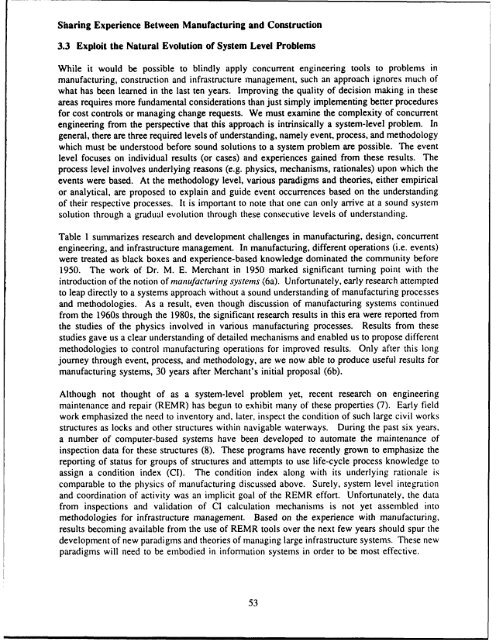Challenges and Opportunities for Innovation in the Public Works ...
Challenges and Opportunities for Innovation in the Public Works ...
Challenges and Opportunities for Innovation in the Public Works ...
Create successful ePaper yourself
Turn your PDF publications into a flip-book with our unique Google optimized e-Paper software.
Shar<strong>in</strong>g Experience Between Manufactur<strong>in</strong>g <strong>and</strong> Construction<br />
3.3 Exploit <strong>the</strong> Natural Evolution of System Level Problems<br />
While it would be possible to bl<strong>in</strong>dly apply concurrent eng<strong>in</strong>eer<strong>in</strong>g tools to problems <strong>in</strong><br />
manufactur<strong>in</strong>g, construction <strong>and</strong> <strong>in</strong>frastructure management, such an approach ignores much of<br />
what has been learned <strong>in</strong> <strong>the</strong> last ten years. Improv<strong>in</strong>g <strong>the</strong> quality of decision mak<strong>in</strong>g <strong>in</strong> <strong>the</strong>se<br />
areas requires more fundamental considerations than just simply implement<strong>in</strong>g better procedures<br />
<strong>for</strong> cost controls or manag<strong>in</strong>g change requests. We must exam<strong>in</strong>e <strong>the</strong> complexity of concurrent<br />
eng<strong>in</strong>eer<strong>in</strong>g from <strong>the</strong> perspective that this approach is <strong>in</strong>tr<strong>in</strong>sically a system-level problem. In<br />
general, <strong>the</strong>re are three required levels of underst<strong>and</strong><strong>in</strong>g, namely event, process, <strong>and</strong> methodology<br />
which must be understood be<strong>for</strong>e sound solutions to a system problem are possible. The event<br />
level focuses on <strong>in</strong>dividual results (or cases) <strong>and</strong> experiences ga<strong>in</strong>ed from <strong>the</strong>se results. The<br />
process level <strong>in</strong>volves underly<strong>in</strong>g reasons (e.g. physics, mechanisms, rationales) upon which <strong>the</strong><br />
events were based. At <strong>the</strong> methodology level, various paradigms <strong>and</strong> <strong>the</strong>ories, ei<strong>the</strong>r empirical<br />
or analytical, are proposed to expla<strong>in</strong> <strong>and</strong> guide event occurrences based on <strong>the</strong> underst<strong>and</strong><strong>in</strong>g<br />
of <strong>the</strong>ir respective processes. It is important to note that one can only arrive at a sound system<br />
solution through a gradual evolution through <strong>the</strong>se consecutive levels of underst<strong>and</strong><strong>in</strong>g.<br />
Table I summarizes research <strong>and</strong> development challenges <strong>in</strong> manufactur<strong>in</strong>g, design, concurrent<br />
eng<strong>in</strong>eer<strong>in</strong>g, <strong>and</strong> <strong>in</strong>frastructure management. In manufactur<strong>in</strong>g, different operations (i.e. events)<br />
were treated as black boxes <strong>and</strong> experience-based knowledge dom<strong>in</strong>ated <strong>the</strong> community be<strong>for</strong>e<br />
1950. The work of Dr. M. E. Merchant <strong>in</strong> 1950 marked significant turn<strong>in</strong>g po<strong>in</strong>t with <strong>the</strong><br />
<strong>in</strong>troduction of <strong>the</strong> notion of manufactur<strong>in</strong>g systems (6a). Un<strong>for</strong>tunately, early research attempted<br />
to leap directly to a systems approach without a sound underst<strong>and</strong><strong>in</strong>g of manufactur<strong>in</strong>g processes<br />
<strong>and</strong> methodologies. As a result, even though discussion of manufactur<strong>in</strong>g systems cont<strong>in</strong>ued<br />
from <strong>the</strong> 1960s through <strong>the</strong> 1980s, <strong>the</strong> significant research results <strong>in</strong> this era were reported from<br />
<strong>the</strong> studies of <strong>the</strong> physics <strong>in</strong>volved <strong>in</strong> various manufactur<strong>in</strong>g processes. Results from <strong>the</strong>se<br />
studies gave us a clear underst<strong>and</strong><strong>in</strong>g of detailed mechanisms <strong>and</strong> enabled us to propose different<br />
methodologies to control manufactur<strong>in</strong>g operations <strong>for</strong> improved results. Only after this long<br />
journey through event, process, <strong>and</strong> methodology, are we now able to produce useful results <strong>for</strong><br />
manufactur<strong>in</strong>g systems, 30 years after Merchant's <strong>in</strong>itial proposal (6b).<br />
Although not thought of as a system-level problem yet, recent research on eng<strong>in</strong>eer<strong>in</strong>g<br />
ma<strong>in</strong>tenance <strong>and</strong> repair (REMR) has begun to exhibit many of <strong>the</strong>se properties (7). Early field<br />
work emphasized <strong>the</strong> need to <strong>in</strong>ventory <strong>and</strong>, later, <strong>in</strong>spect <strong>the</strong> condition of such large civil works<br />
structures as locks <strong>and</strong> o<strong>the</strong>r structures with<strong>in</strong> navigable waterways. Dur<strong>in</strong>g <strong>the</strong> past six years,<br />
a number of computer-based systems have been developed to automate <strong>the</strong> ma<strong>in</strong>tenance of<br />
<strong>in</strong>spection data <strong>for</strong> <strong>the</strong>se structures (8). These programs have recently grown to emphasize <strong>the</strong><br />
report<strong>in</strong>g of status <strong>for</strong> groups of structures <strong>and</strong> attempts to use life-cycle process knowledge to<br />
assign a condition <strong>in</strong>dex (CI). The condition <strong>in</strong>dex along with its underly<strong>in</strong>g rationale is<br />
comparable to <strong>the</strong> physics of manufactur<strong>in</strong>g discussed above. Surely, system level <strong>in</strong>tegration<br />
<strong>and</strong> coord<strong>in</strong>ation of activity was an implicit goal of <strong>the</strong> REMR ef<strong>for</strong>t. Un<strong>for</strong>tunately, <strong>the</strong> data<br />
from <strong>in</strong>spections <strong>and</strong> validation of CI calculation mechanisms is not yet assernbled <strong>in</strong>to<br />
methodologies <strong>for</strong> <strong>in</strong>frastructure management. Based on <strong>the</strong> experience with manufactur<strong>in</strong>g,<br />
results becom<strong>in</strong>g available from <strong>the</strong> use of REMR tools over <strong>the</strong> next few years should spur <strong>the</strong><br />
development of new paradigms <strong>and</strong> <strong>the</strong>ories of manag<strong>in</strong>g large <strong>in</strong>frastructure systems. These new<br />
paradigms will need to be embodied <strong>in</strong> <strong>in</strong>fonriation systems <strong>in</strong> order to be most effective.<br />
53







